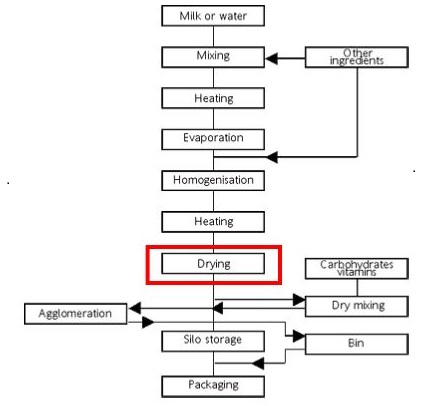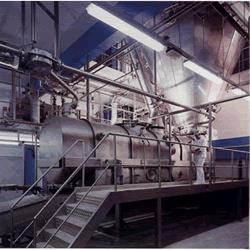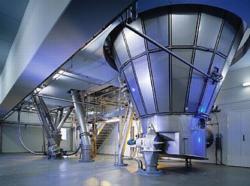Difference between revisions of "Drying in baby food"
| Line 17: | Line 17: | ||
| − | Drying takes place in a spray dryer system. The concentrate is atomised to droplets, using either a centrifugal or a nozzle atomiser, and it is | + | Drying takes place in a spray dryer system. The spray dryer may be either a horizontal box-type dryer or a vertical funnel shaped dryer. The concentrate is atomised to droplets, using either a centrifugal or a nozzle atomiser. As the droplets of product pass through the dryer, water is evaporated and the dry powder falls to the bottom of the spray dryer. The warm powder is passed through a fluidized bed where it is cooled by a stream of chilled air. At the end of the fluidized bed, the powder is cooled to approximately 21°C (70°F). Typically, HEPA-filtered air is supplied to the spray dryer and fluidized bed to minimize the risk of product contamination. The spray drying stage of infant formula production is key to producing a powder with a long stable shelf life. |
| − | + | ||
A spray dryer system typically consists of: | A spray dryer system typically consists of: | ||
| Line 55: | Line 54: | ||
=== Typical Parameters === | === Typical Parameters === | ||
The drying temperature and solids content are a high as possible In order to improve production efficiency. Product composition, however, is a decisive factor as to what parameters can be selected. | The drying temperature and solids content are a high as possible In order to improve production efficiency. Product composition, however, is a decisive factor as to what parameters can be selected. | ||
| + | |||
In general: | In general: | ||
| + | |||
The drying efficiency and capacity of a spray dryer is increased by increasing the difference between the drying air and exhaust air temperature. | The drying efficiency and capacity of a spray dryer is increased by increasing the difference between the drying air and exhaust air temperature. | ||
High ambient air humidity requires a lower spray drying temperature or a dehumidification of the air, which obviously increases the production costs. | High ambient air humidity requires a lower spray drying temperature or a dehumidification of the air, which obviously increases the production costs. | ||
| + | |||
| + | |||
Solids content prior to spray drying 45-60% | Solids content prior to spray drying 45-60% | ||
| + | |||
Solids content after spray drying approx 97% | Solids content after spray drying approx 97% | ||
| + | |||
| + | |||
| + | Typical spray dryer inlet air temperatures: 138-204°C (280-400°F) depending on the dryer model and process requirements | ||
| + | |||
| + | Typical spray dryer outlet temperature: 104°C (220°F) | ||
| + | |||
| + | Temperature of the powder at the spray dryer outlet ranges from 43-79°C (110-175°F) | ||
| + | |||
| + | Typical powder temperature at end of spray drying stage: 21°C (70°F) | ||
Back to [[Subsection DA food|EFFICIENCY FINDER OF FOOD INDUSTRY]] | Back to [[Subsection DA food|EFFICIENCY FINDER OF FOOD INDUSTRY]] | ||
Revision as of 18:31, 7 May 2015
Back to EFFICIENCY FINDER OF FOOD INDUSTRY
General Description
For a general overview of infant formula production, please see ‘Evaporation’ in the ‘Baby Food’ subsection.
Figure: Infant formula baby food process flow sheet
Source: http://www.spx.com/en/apv/industries/dairy/evaporated-dried/baby-food/
Drying
Drying takes place in a spray dryer system. The spray dryer may be either a horizontal box-type dryer or a vertical funnel shaped dryer. The concentrate is atomised to droplets, using either a centrifugal or a nozzle atomiser. As the droplets of product pass through the dryer, water is evaporated and the dry powder falls to the bottom of the spray dryer. The warm powder is passed through a fluidized bed where it is cooled by a stream of chilled air. At the end of the fluidized bed, the powder is cooled to approximately 21°C (70°F). Typically, HEPA-filtered air is supplied to the spray dryer and fluidized bed to minimize the risk of product contamination. The spray drying stage of infant formula production is key to producing a powder with a long stable shelf life.
A spray dryer system typically consists of:
- one or several high pressure nozzles or a rotary atomizer wheel for the atomization of the concentrate
- a drying chamber/tower
- an integrated fluid bed for secondary drying
- an external fluidizer
- one or several cyclone(s) and/or bag filter(s) as an air/powder separation system
- a fines return system to improve the agglomeration
When designing a spray drying plant for powder production the following must be taken into consideration:
- production time between CIP cleaning
- powder structure
- drying parameters
To order to minimise the need for cleaning, plants may include an efficient high-pressure air broom, which reduces the powder deposits in the dryer, thereby achieving prolonged running times.
Figure:Lower part of spray drying chamber and Vibro-Fluidizer® for after drying / cooling of powder. Source: GEA Niro
Figure: Spray Drying Unit. Source: GEA Niro
Application
Baby Food
Typical Parameters
The drying temperature and solids content are a high as possible In order to improve production efficiency. Product composition, however, is a decisive factor as to what parameters can be selected.
In general:
The drying efficiency and capacity of a spray dryer is increased by increasing the difference between the drying air and exhaust air temperature. High ambient air humidity requires a lower spray drying temperature or a dehumidification of the air, which obviously increases the production costs.
Solids content prior to spray drying 45-60%
Solids content after spray drying approx 97%
Typical spray dryer inlet air temperatures: 138-204°C (280-400°F) depending on the dryer model and process requirements
Typical spray dryer outlet temperature: 104°C (220°F)
Temperature of the powder at the spray dryer outlet ranges from 43-79°C (110-175°F)
Typical powder temperature at end of spray drying stage: 21°C (70°F)


